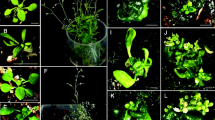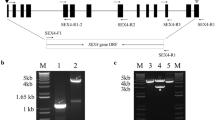Abstract
The genes associated with the dwarf phenotype have been utilized in crop breeding to prevent lodging and stem breakage. Brevis plant1 (Bv1), encoding a putative inositol polyphosphate 5-phosphatase (5PTase), has been associated with stem elongation in maize (Zea mays L.); however, the enzymatic activity of BV1 has not been experimentally characterized. In this study, the phosphatase activity of BV1 was verified with biochemical assays. BV1 demonstrated type II 5PTase activity capable of hydrolyzing both inositol polyphosphates and phosphoinositides. Similar to other type II 5PTases that share similar sequences and common domain architecture with BV1, the enzymatic activity of BV1 is sensitive to changes in Mg2+ and pH. 367G-R and 565S-L are two mutations in Bv1 that have been associated with the dwarfing phenotype in maize. To characterize the dwarfing mechanism, mutant BV1 proteins were expressed in vitro and assayed for phosphatase activity. The results showed that both mutations significantly reduced the enzymatic activity of BV1, but neither altered its substrate specificity and dependence on Mg2+ and pH. This biochemical verification of BV1 as a type II 5PTase is important as it sheds light on the molecular basis of deficient BV1-mediated dwarfing phenotype.




Similar content being viewed by others
Abbreviations
- Bv1 :
-
Brevis plant1
- 5PTase:
-
Inositol polyphosphate 5-phosphatase
- ZZ:
-
Protein-A immunoglobulin G (IgG) binding domains
- TEV:
-
Tobacco etch virus
- PCR:
-
Polymerase chain reaction
- qPCR:
-
Quantitative polymerase chain reaction
- RT:
-
Reverse transcription
- β-Tub :
-
Tubulin beta
- BLAST:
-
Basic Local Alignment Search Tool
References
Avila LM, Cerrudo D, Swanton C, Lukens L (2016) Brevis plant1, a putative inositol polyphosphate 5-phosphatase, is required for internode elongation in maize. J Exp Bot 67:1577–1588
Barrero Farfan ID, Bergsma BR, Johal G, Tuinstra MR (2012) A stable dw3 allele in sorghum and a molecular marker to facilitate selection. Crop Sci 52:2063–2069
Dalrymple DG (1986) Development and spread of high-yielding rice varieties in developing countries
Hargrove TR, Cabanilla VL (1979) The impact of semi-dwarf varieties on Asian rice-breeding programs. Bioscience 29:731–735
Jarvis DL (2009) Baculovirus-insect cell expression systems. Methods Enzymol 463:191–222
Khush GS (1999) Green revolution: preparing for the 21st century. Genome 42:646–655
Khush GS (2001) Green revolution: the way forward. Nat Rev Genet 2:815–822
Knoller AS, Blakeslee JJ, Richards EL, Peer WA, Murphy AS (2010) Brachytic2/ZmABCB1 functions in IAA export from intercalary meristems. J Exp Bot 61:3689–3696
Kodama T, Fukui K, Kometani K (1986) The initial phosphate burst in ATP hydrolysis by myosin and subfragment-1 as studied by a modified mala-chite green method for determination of inorganic phosphate. J Biochem 99:1465–1472
Kumar S, Stecher G, Tamura K (2016) MEGA7: Molecular Evolutionary Genetics Analysis version 7.0 for bigger datasets. Mol Biol Evol 33:1870–1874
Lin WH, Wang Y, Mueller-Roeber B, Brearley CA, Xu ZH, Xue HW (2005) At5PTase13 modulates cotyledon vein development through regulating auxin homeostasis. Plant Physiol 139:1677–1691
Majerus PW, Kisseleva MV, Norris FA (1999) The role of phosphatases in inositol signaling reactions. J Biol Chem 274:10669–10672
Monna L, Kitazawa N, Yoshino R, Suzuki J, Masuda H, Maehara Y, Tanji M, Sato M, Nasu S, Minobe Y (2002) Positional cloning of rice semidwarfing gene, sd-1: rice ‘green revolution gene’ encodes a mutant enzyme involved in gibberellin synthesis. DNA Res 9:11–17
Moore KJ, Moser LE, Vogel KP, Waller SS, Johnson BE, Pedersen JF (1991) Describing and quantifying growth stages of perennial forage grasses. Agron J 83:1073–1077
Olszewski N, Sun TP, Gubler F (2002) Gibberellin signaling: biosynthesis, catabolism, and response pathways. Plant Cell 14:S61–S80
Peng J, Richards DE, Hartley NM, Murphy GP, Devos KM, Flintham JE, Beales J, Fish LJ, Worland AJ, Pelica F, Sudhakar D, Christou P, Snape JW, Gale MD, Harberd NP (1999) ‘Green revolution’ genes encode mutant gibberellin response modulators. Nature 400:256–261
Perera IY, Hung CY, Brady S, Muday GK, Boss WF (2006) A universal role for inositol 1,4,5-trisphosphate-mediated signaling in plant gravitropism. Plant Physiol 140:746–760
Saitou N, Nei M (1987) The neighbor-joining method: a new method for reconstructing phylogenetic trees. Mol Biol Evol 4:406–425
Sasaki A, Ashikari M, Ueguchi-Tanaka M, Itoh H, Nishimura A, Swapan D, Ishiyama K, Saito T, Kobayashi M, Khush GS, Kitano H, Matsuoka M (2002) Green revolution: a mutant gibberellin-synthesis gene in rice. Nature 416:701–702
Sato-Izawa K, Nakaba S, Tamura K, Yamagishi Y, Nakano Y, Nishikubo N, Kawai S, Kajita S, Ashikari M, Funada R, Katayama Y, Kitano H (2012) DWARF50 (D50), a rice (Oryza sativa L.) gene encoding inositol polyphosphate 5-phosphatase, is required for proper development of intercalary meristem. Plant Cell Environ 35:2031–2044
Sauter M, Kende H (1992) Gibberellin-induced growth and regulation of the cell division cycle in deepwater rice. Planta 188:362–368
Smith TF, Gaitatzes C, Saxena K, Neer EJ (1999) The WD repeat: a common architecture for diverse functions. Trends Biochem Sci 24:181–185
Spielmeyer W, Ellis MH, Chandler PM (2002) Semidwarf (sd-1), ‘green revolution’ rice, contains a defective gibberellin 20-oxidase gene. Proc Natl Acad Sci USA 99:9043–9048
Tsai A, Carstens RP (2006) An optimized protocol for protein purification in cultured mammalian cells using a tandem affinity purification approach. Nat Protoc 1:2820–2827
Whisstock JC, Wiradjaja F, Waters JE, Gurung R (2002) The structure and function of catalytic domains within inositol polyphosphate 5-phosphatases. IUBMB Life 53:15–23
Zhong R, Ye ZH (2004) Molecular and biochemical characterization of three WD-repeat-domain-containing inositol polyphosphate 5-phosphatases in Arabidopsis thaliana. Plant Cell Physiol 45:1720–1728
Zhong R, Burk DH, Morrison WH III, Ye ZH (2004) FRAGILE FIBER3, an Arabidopsis gene encoding a type II inositol polyphosphate 5-phosphatase, is required for secondary wall synthesis and actin organization in fiber cells. Plant Cell 16:3242–3259
Zuckerkandl E, Pauling L (1965) Evolutionary divergence and convergence in proteins. In: Bryson V, Vogel HJ (eds) Evolving genes and proteins. Academic Press, New York, pp 97–166
Author information
Authors and Affiliations
Corresponding author
Ethics declarations
Conflict of interest
The authors declare that there is no conflict of interest regarding the publication of this paper.
Rights and permissions
About this article
Cite this article
Chen, Y., Cai, Q. & Hao, S. The maize brevis plant1 is a type II inositol polyphosphate 5-phosphatase. J. Plant Biochem. Biotechnol. 27, 215–222 (2018). https://doi.org/10.1007/s13562-017-0433-7
Received:
Accepted:
Published:
Issue Date:
DOI: https://doi.org/10.1007/s13562-017-0433-7




